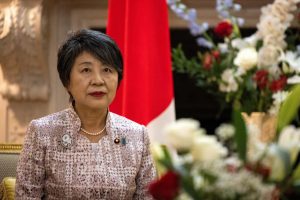
Nepal’s GDP growth recorded 1.9 percent in 2023 and 3.9 percent in 2024: World Bank
The World Bank has projected Nepal’s GDP growth to contract at 1.9 percent. Launching its ‘South Asia Development Update and Nepal Development Update, October 2023’, the World Bank stated that the GDP is expected to increase in the next fiscal year, compared to the current year.
The WB Outlook states that the growth is expected to rebound to 3.9 percent in FY24 and 5 percent in FY25, supported by the lagged impact of lifting import restrictions and the gradual loosening of monetary policy.
The Bank has pointed out the low economic growth rate (1.9 percent), the growing current account deficit and inflation this year as the challenges.
Compared to the GDP, the current account deficit is expected to touch around 6.1 percent and the annual average inflation will be 7.8 percent this year, the WB said. It projected that Nepal will suffer intense inflation in the coming two years.
The WB said inflation will be 7.5 percent in 2024 and 6.4 percent in 2025.
The World Bank has projected Nepal’s GDP growth to contract at 1.9 percent. Launching its ‘South Asia Development Update and Nepal Development Update, October 2023’, the World Bank stated that the GDP is expected to increase in the next fiscal year, compared to the current year.
The WB Outlook states that the growth is expected to rebound to 3.9 percent in FY24 and 5 percent in FY25, supported by the lagged impact of lifting import restrictions and the gradual loosening of monetary policy.
The Bank has pointed out the low economic growth rate (1.9 percent), the growing current account deficit and inflation this year as the challenges.
Compared to the GDP, the current account deficit is expected to touch around 6.1 percent and the annual average inflation will be 7.8 percent this year, the WB said. It projected that Nepal will suffer intense inflation in the coming two years.
The WB said inflation will be 7.5 percent in 2024 and 6.4 percent in 2025.
Situation in 2023
Strong energy sector growth helped to avoid an industrial contraction, since manufacturing and construction outputs shrank. Hydroelectric generation increased significantly for the second year in row and added close to 500 megawatts of hydroelectric power to the national grid.
Nepal nevertheless remains a net energy importer, it is stated.
The Outlook states that slow credit growth and import restrictions contributed to a reduction in private investment on the demand side. Lower capital expenditure and revenue underperformance drove lower public investment. As a result, total investment decreased by more than 10 percent, a sharper reduction than in FY20. Private consumption remained robust, owing to strong remittance inflows.
Inflation increased for the third successive year in FY23, and the increase was broadbased. Food prices rose due to supply side shocks and domestic policy changes. Non-food prices were pushed by higher housing and utility prices. The persistence of high inflation impedes an effective policy mix to stimulate growth while containing external imbalances.
Domestic policies and India’s trade restriction measures invoked a steep reduction of goods imports. Remittance inflows increased in FY23, following high outward migration in the previous year. Exports stagnated below their pre-pandemic level, caused also by a real appreciation due to Nepal’s persistently high inflation.
Overall, the current account deficit decreased significantly, and the level of foreign currency reserves increased above its policy floor.
Hydropower production contributed to the industrial sector growth. Total investment cooled while private consumption remained strong.
Similarly, it is stated that inflation rose for a third consecutive year in part due to supply shocks and domestic policy changes.
External imbalances improved significantly as goods imports fell and remittance inflows increased.
The economy faced a slowdown in FY23 primarily due to monetary tightening and import restriction measures. The central bank raised its policy rate in early FY23 to slow credit growth to the private sector and to support the correction of external imbalances. In synergy with import restrictions and higher international prices, credit growth to the private sector slowed compared to the previous year. Deposits grew at the same time, supported by higher real interest rates and several government incentives targeting remittance deposits, the World Bank said.
The contraction of imports caused a sharp decline in fiscal revenues, as more than half of total revenues are trade related. Because expenditures contracted at a much slower pace than revenues, the fiscal deficit nearly doubled to 6.1 percent of GDP, the highest deficit recorded in more than two decades. Overall, public debt increased due to the weaker fiscal performance to 41.3 percent of GDP.
Outlook, Risks, and Challenges
Growth is expected to rebound to 3.9 percent in FY24 and 5 percent in FY25, supported by the lagged impact of lifting import restrictions and the gradual loosening of monetary policy. The continued expansion of hydroelectric production through the commissioning of new projects is expected to carry stronger growth in the industrial sector.
Wholesale and retail trade are expected to benefit from the lifting of import restrictions and boost service sector growth. Only agricultural sector growth is expected to slow in FY24, due to the impact of the lumpy skin disease on livestock and a decline in rice paddy production.
Inflation is expected to remain elevated, weighing on people’s real disposable incomes and private consumption. Looser monetary policy and the lifting of import restrictions imply an increase in goods imports over the medium-term. Policies to contain credit growth and lower one-off imports, including of COVID-19 vaccines, are expected to keep imports below its FY22 historic high.
The Outlook states that near-record migration of Nepali workers should be reflected in strong medium-term remittance inflows which, however, are not expected to balance the goods and services trade deficit. Consequently, the current account deficit is expected to widen to 3.7 percent of GDP in FY25, and 4.6 percent of GDP in FY25.
Revenues are expected to increase in line with higher goods imports, given that taxation focuses heavily on trade. The FY24 budget envisions lower federal spending on capital investment and fiscal transfers to subnational governments, yet higher debt servicing costs. Overall, the recovery of revenues is expected to reduce the fiscal deficit to 3.5 percent in FY24 and 3.3 percent in FY25.
Together with the rebound in growth, tighter fiscal policy is expected to keep the overall public debt burden contained at around 41 percent of GDP in FY24 and FY25.
High inflation expectations continue to weigh on the outlook and require a careful balancing of policies to stimulate growth and to contain external imbalances and inflation. Lumpy skin disease and an erratic monsoon could weigh more than expected on agricultural output, and services and industry could be affected by higher-than-expected import prices or further export bans from India.
The recent sharp increase in debt servicing costs highlights the importance of containing the fiscal deficit and ensuring sufficient fiscal space to undertake longer-term investments, the WB Outlook said.
ADB projection
Meanwhile, the Asian Development Bank (ADB) had made public its ‘Nepal Microeconomic Update’ Report some days back. In its update, the ADB had stated that Nepal’s economy will improve in 2024 compared to 2023.
The ADB report said Nepal’s economic growth rate would be 1.9 percent in 2023 and 4.3 percent in 2024.















Comments